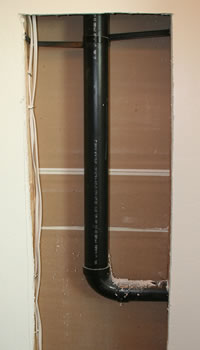How To Remove an Intact Piece of Drywall
 |
Occasionally I have to open a section of wall to make a repair, for instance to replace a section of broken pipe. It saves me a lot of repair and patching time if I can preserve the section of drywall and then reinstall it when the repair work is done. Furthermore, some texturing is fairly difficult to replicate. I find it much easier to just patch the joints and fastener holes than to try to blend an entire section with the rest of the wall.
There are two scenarios I typically encounter. The first is accessing a section of wall between two studs. The second scenario is where the area is wider than a single stud bay. In the first case, I locate the position of the studs and then cut the drywall just inside the stud. In other words, I cut through the drywall where it has no stud behind it. I then look for the edge of the other stud, in most cases about 14 inches over, and cut there. In order to prevent the piece of drywall from falling into the stud bay, I drive a screw part way into the center of the section of drywall and use it as a handle. I then cut across the top and bottom and remove the piece. Because there may be unexpected wires or pipes in the stud bay, I make very shallow cuts, just deep enough to get through the drywall, about 5/8 of an inch thick in most cases. I use a drywall saw, but a razor knife will help ensure you don't go too deep. I always start with the razor knife to cut through the drywall outer coat of paper. This prevents it from tearing and gives me a nice clean edge.
Some people like to cut down the center of the stud so that they have something to fasten the piece back to. That is fine except that it leaves a very small area for fasteners, and you may also have to fasten the section of wall you didn't remove in addition to the piece you did remove. Instead, I nail a small section of 2x4 to the existing 2x4's and then use that to refasten the drywall section.
In the case of drywall fastened over a section wider than a stud bay, I make all my cuts and then gently flex the wallboard. The screws or nails will often telegraph through the finish allowing me to locate and remove them. In this way I preserve the section and only have to patch the small holes for the fasteners. This does not always work, and when it doesn't I carefully pull the drywall away from the wall to pull the fastener through the back of the wallboard. If neither works, or the piece is just too big, then I cut each section from each stud bay and leave the narrow strips that are fastened to the studs. When I replace the piece, I do it the same way as described above.





